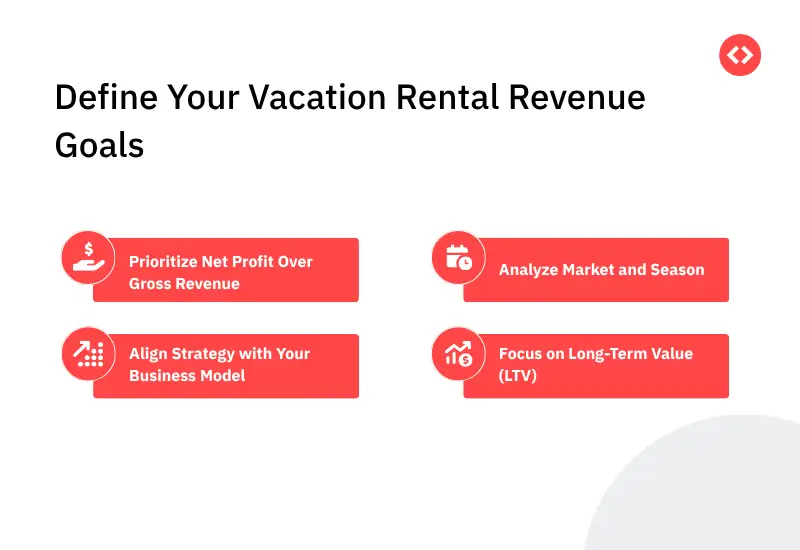Updated : Nov 12, 2025
In 2025, the global vacation rental market is set to generate a revenue of $107.87bn. By 2030, experts predict the sector could have a market volume of US$149.19bn. This impressive rate of growth shows that there’s significant profitability in the short-term rental industry. However, many operators are failing to capitalize on this potential profit by committing revenue-optimization mistakes and focusing solely on increasing bookings, overlooking deeper strategic considerations.
Avoiding common pitfalls can lead to more stable earnings, improved cash flow, and, importantly, long-term business viability. In this guide, we’ll take a look at the frequent mistakes vacation rental businesses make, as well as the proven strategies that can help landlords and company owners optimize their revenue and drive profitability.
Defining Revenue Goals: What Are You Optimizing For?
Revenue optimization should begin by defining what success looks like for you. Without a clear objective, it’s easy to make decisions that seem effective in the short term, but ultimately undermine the financial health of your vacation rental business.

1. Focus on Net Profit, Not Just Gross Revenue
Maximizing gross income—through higher rates or fuller calendars—can be misleading if costs are not managed in parallel. Increased bookings can often lead to higher expenses — such as utilities, maintenance, and labor — that can significantly impact your bottom line.
Using specialist bookkeeping software or working with an accountant to analyze your income and expenses will give you a clearer idea of where your ideal occupancy rate lies. This can help focus your marketing and pricing strategies to maximize profitability.
A core part of bookkeeping in short-term rental operations is consistently recording and categorizing those variable and fixed costs so you can see how each booking affects profit. Companies that prioritize long-term value creation—through profitability, sustainability, and customer trust—outperform those that focus purely on short-term revenue spikes.
2. Consider Market-Specific and Seasonal Trends
Short-term rental performance is highly dependent on geography and seasonality. Demand patterns can fluctuate based on the location of your properties, local events, weather, and travel trends. A revenue strategy that works in one market may not be applicable elsewhere.
Operators should regularly analyze occupancy rates, booking windows, and average nightly rates across different seasons to develop flexible, context-aware pricing strategies.
3. Align Strategy with Business Model
Revenue goals should vary based on the type of operation you’re running. An owner managing one or two properties may prioritize cash flow or mortgage coverage. In contrast, a property manager overseeing multiple homes might focus on maximizing revenue per property or improving portfolio-wide profitability.
Understanding the business model, including any owner or investor expectations, is critical when setting and measuring optimization goals.
4. Plan for Long-Term Value
If the business has plans for expansion, sale, or investment, the revenue strategy should be aligned with long-term performance indicators. These indicators may include earnings before interest, taxes, depreciation, and amortization (EBITDA), or average revenue growth.
Optimization decisions made today can influence business valuation and future financing opportunities. The Small Business Administration offers guidance on how financial performance and earnings potential impact business valuation.
Proven Revenue Optimization Strategies
Several strategies can help rental operators improve revenue while maintaining or increasing profitability. These techniques require regular analysis and adaptation based on the internal and external variables that may affect your business.
- Adjust Nightly Rates Based on Demand: Rates should reflect current market conditions, not static pricing. Monitoring booking trends and local demand patterns helps inform better pricing decisions.
- Implement Flexible Minimum Stay Requirements: Modifying minimum length-of-stay rules to align with demand patterns—such as requiring longer stays during peak seasons or allowing shorter stays to fill calendar gaps—can improve both occupancy and revenue.
- Diversify Booking Channels: Listing properties across multiple platforms increases visibility and enables operators to compare channel performance. Direct bookings may offer higher margins, while third-party platforms can drive traffic during slower periods.
- Add Revenue Through Value-Added Services: Additional fees or services—such as early check-in, late check-out, pet accommodations, or cleaning fees—can meaningfully boost revenue without altering base rates.
- Segment Properties for Targeted Strategies: Treating all properties the same can limit revenue potential. Grouping properties by location, size, or amenities enables more accurate pricing and performance benchmarking.
Stop Guessing. Start Calculating Profit.
Avoid the costly mistakes listed here. Use smart, data-driven pricing and profit analysis tools to ensure you're maximizing net earnings, not just gross revenue.
See Your Profit PotentialMistakes to Avoid in Revenue Optimization
There are a number of avoidable errors that all too often cause you to limit your revenue unintentionally. Recognizing and correcting these can have an immediate impact on the financial performance of your vacation rental properties.
- Overpricing During Low Demand Periods: Holding out for high rates during slow seasons can result in empty calendars. Accepting slightly lower rates during these periods can ensure consistent income and cash flow.
- Ignoring Operating Costs: High occupancy may increase variable expenses. If these costs aren’t factored into the pricing strategy, profit margins may suffer even as revenue increases.
- Overlooking the Importance of Listing Quality: Even the best pricing strategy won’t perform well if listings are poorly presented. High-quality images, clear descriptions, and accurate amenity lists help drive booking conversions. A study by FlipKey found that travelers were 83% more likely to enquire about properties with 20 or more photos in the listing.
- Relying Entirely on Automation: While automation can assist in rate adjustments, it should be reviewed regularly to account for local knowledge, special events, or unforeseen changes in demand. Algorithms alone cannot replace strategic oversight.
- Separating Revenue from Financial Reporting: Revenue data should be fully integrated with accounting and operational reporting. Without this alignment, it isn’t easy to understand true profitability or make informed decisions about future investments.
Expert Insights to Maximize Growth
Calculate the Break-Even Point
Understanding the minimum daily rate required to cover all fixed and variable costs allows operators to make informed decisions about discounting and promotional pricing.
Monitor Key Metrics Regularly
Key performance indicators such as revenue per available night, average length of stay, booking lead time, and cancellation rates should be reviewed frequently to identify trends and potential opportunities.
Benchmark Against Industry Averages
Comparing performance to similar properties or portfolios can highlight strengths and weaknesses in your business operations.
Integrate Financial and Operational Planning
Coordinating accounting, tax planning, and revenue optimization creates a stronger foundation for growth. If your financial data is well-structured, it will be easier to make informed decisions and improve your long-term outcomes.
Provide Transparent Owner Reporting
For property managers representing clients, clear and consistent reporting builds trust and supports client retention. Reports should include revenue breakdowns, expense tracking and performance comparisons over time.
The Bottom Line
Revenue optimization in the vacation rental industry requires a strategic approach that aligns financial, operational and market-driven decisions to achieve sustainable profitability. Avoiding common mistakes and using specialist tools and services can significantly enhance business performance, giving small businesses and entrepreneurs the revenue and resources they need to thrive.







